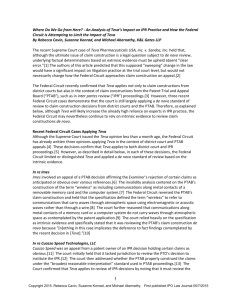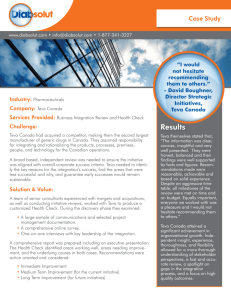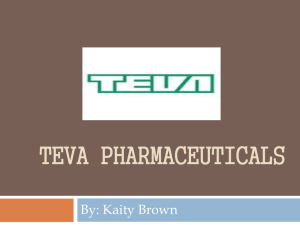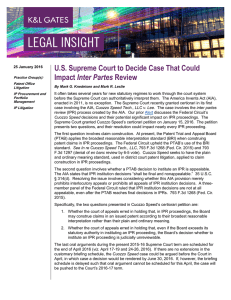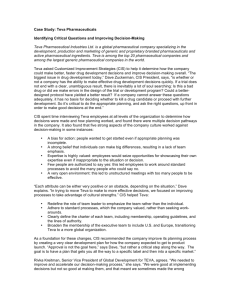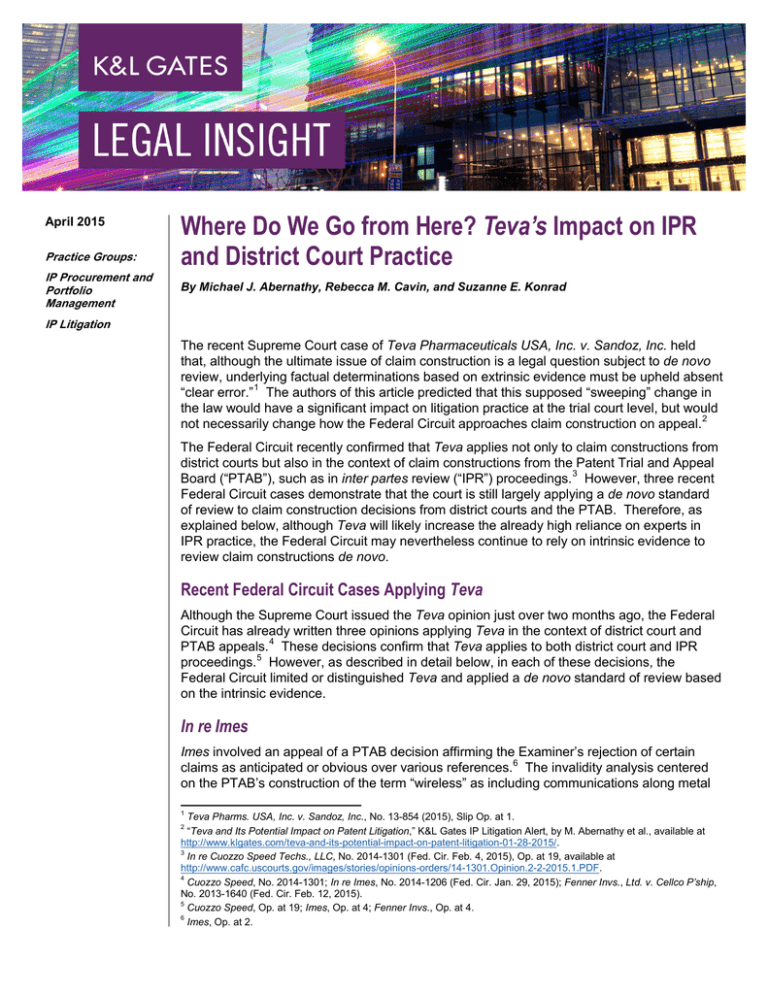
April 2015
Practice Groups:
IP Procurement and
Portfolio
Management
Where Do We Go from Here? Teva’s Impact on IPR
and District Court Practice
By Michael J. Abernathy, Rebecca M. Cavin, and Suzanne E. Konrad
IP Litigation
The recent Supreme Court case of Teva Pharmaceuticals USA, Inc. v. Sandoz, Inc. held
that, although the ultimate issue of claim construction is a legal question subject to de novo
review, underlying factual determinations based on extrinsic evidence must be upheld absent
“clear error.” 1 The authors of this article predicted that this supposed “sweeping” change in
the law would have a significant impact on litigation practice at the trial court level, but would
not necessarily change how the Federal Circuit approaches claim construction on appeal.2
The Federal Circuit recently confirmed that Teva applies not only to claim constructions from
district courts but also in the context of claim constructions from the Patent Trial and Appeal
Board (“PTAB”), such as in inter partes review (“IPR”) proceedings. 3 However, three recent
Federal Circuit cases demonstrate that the court is still largely applying a de novo standard
of review to claim construction decisions from district courts and the PTAB. Therefore, as
explained below, although Teva will likely increase the already high reliance on experts in
IPR practice, the Federal Circuit may nevertheless continue to rely on intrinsic evidence to
review claim constructions de novo.
Recent Federal Circuit Cases Applying Teva
Although the Supreme Court issued the Teva opinion just over two months ago, the Federal
Circuit has already written three opinions applying Teva in the context of district court and
PTAB appeals. 4 These decisions confirm that Teva applies to both district court and IPR
proceedings.5 However, as described in detail below, in each of these decisions, the
Federal Circuit limited or distinguished Teva and applied a de novo standard of review based
on the intrinsic evidence.
In re Imes
Imes involved an appeal of a PTAB decision affirming the Examiner’s rejection of certain
claims as anticipated or obvious over various references.6 The invalidity analysis centered
on the PTAB’s construction of the term “wireless” as including communications along metal
1
Teva Pharms. USA, Inc. v. Sandoz, Inc., No. 13-854 (2015), Slip Op. at 1.
“Teva and Its Potential Impact on Patent Litigation,” K&L Gates IP Litigation Alert, by M. Abernathy et al., available at
http://www.klgates.com/teva-and-its-potential-impact-on-patent-litigation-01-28-2015/.
3
In re Cuozzo Speed Techs., LLC, No. 2014-1301 (Fed. Cir. Feb. 4, 2015), Op. at 19, available at
http://www.cafc.uscourts.gov/images/stories/opinions-orders/14-1301.Opinion.2-2-2015.1.PDF.
4
Cuozzo Speed, No. 2014-1301; In re Imes, No. 2014-1206 (Fed. Cir. Jan. 29, 2015); Fenner Invs., Ltd. v. Cellco P’ship,
No. 2013-1640 (Fed. Cir. Feb. 12, 2015).
5
Cuozzo Speed, Op. at 19; Imes, Op. at 4; Fenner Invs., Op. at 4.
6
Imes, Op. at 2.
2
Where Do We Go from Here? Teva’s Impact on IPR and District Court Practice
contacts of a removable memory card and the computer system.7 The Federal Circuit
reversed the PTAB’s claim construction and held that the specification defined the term
“wireless” to refer to communications that carry waves through atmospheric space using
electromagnetic or acoustic waves rather than through a wire. 8 The court further reasoned
that communications along metal contacts of a memory card or a computer system do not
carry waves through atmospheric space as contemplated by the patent application. 9 The
court relied heavily on the specification as intrinsic evidence and specifically stated that it
was reviewing the PTAB’s claim construction de novo because “[n]othing in this case
implicates the deference to fact findings contemplated by the recent decision in [Teva].” 10
In re Cuozzo Speed Technologies, LLC
Cuozzo Speed was an appeal from a patent owner of an IPR decision holding certain claims
as obvious. 11 The court initially held that it lacked jurisdiction to review the PTAB’s decision
to institute the IPR. 12 The court then addressed whether the PTAB properly construed the
claims under the “broadest reasonable interpretation” standard used in PTAB proceedings.13
The court confirmed that Teva applies to review of IPR decisions by noting that it must
review the PTAB’s claim construction under the standards set forth in Teva.14 Nevertheless,
the court stated that it would review the claim construction de novo “[b]ecause there is no
issue here as to extrinsic evidence.” 15 Notably, the underlying IPR proceeding was the first
IPR decision and involved affidavits attesting to the accuracy of translations of certain
references, but no expert declarations on the construction of claim terms. 16 17
The court affirmed the PTAB’s construction of the disputed limitation “integrally attached”
based on the specification and prosecution history. The court then affirmed the PTAB’s
finding of obviousness and the PTAB’s denial of the patent owner’s motion to amend the
claims. 18
Fenner Investments, Ltd. v. Cellco Partnership
Unlike the PTAB decisions at issue in Imes and Cuozzo Speed, Fenner Investments involved
the appeal of a district court claim construction. 19 The court noted Teva’s holding that
7
Id. at 3.
Id. at 4.
9
Id.
10
Id.
11
Cuozzo Speed, Op. at 2.
12
Id. at 5-6. The court based its reasoning on (1) the explicit language in 35 U.S.C. § 314(d) prohibiting appeal of a
decision to institute an IPR, and (2) its prior decision in In re Hiniker holding that a flawed decision to institute
reexamination is not a basis for setting aside a final decision in reexamination. Id. at 6-8.
13
Id. at 19.
14
Id.
15
Id.
16
“CAFC Affirms PTAB in First Inter Partes Review Appeal,” by G. Quinn, IPWatchdog (Feb. 4, 2015), available at
http://www.ipwatchdog.com/2015/02/04/cafc-affirms-ptab-in-first-inter-partes-review-appeal/id=54464/.
17
PTAB Trials, Case No. IPR2012-00001, available at
https://ptabtrials.uspto.gov/prweb/PRWebLDAP2/HcI5xOSeX_yQRYZAnTXXCg%5B%5B*/!STANDARD?UserIdentifier=s
earchuser.
18
Cuozzo Speed, Op. at 21-26.
19
Fenner Invs., Op. at 2-4.
8
2
Where Do We Go from Here? Teva’s Impact on IPR and District Court Practice
intrinsic evidence and the ultimate issue of claim construction are reviewed de novo,
whereas subsidiary fact findings based on extrinsic evidence are reviewed for “clear error.” 20
Nonetheless, the Federal Circuit focused entirely on the intrinsic evidence and affirmed the
district court’s claim construction of the term “personal identification number.” 21 First, the
court noted that the claims are not analyzed in the abstract and instead are construed from
the perspective of one of ordinary skill in the art at the time of the invention based on the
intrinsic evidence. 22 Second, the court analyzed the use of the term “personal identification
number” in the specification. 23 Specifically, the court noted the specification’s discussion of
overcoming the prior art problems associated with locating and tracking personal
identification numbers by setting up “a user-centered system in which users have personal
identification numbers that are associated with the individual.”24 The court also relied on
arguments during prosecution in which the applicant distinguished its “user-centered design”
from the device-centered communication system of the prior art. 25 The court then dismissed
the applicant’s arguments that the district court’s claim construction renders the claims
“inoperable” or is negated by the doctrine of claim differentiation. 26
Impact on IPR Practice and District Court Practice
Although IPR proceedings do not have a long history, the vast majority of patent practitioners
are using experts to support their IPR petitions, with some estimating the number of petitions
supported by expert declaration near 90 percent. 27 28 Other data indicates a slight increase
in the percentage of granted petitions when an expert declaration is employed.29 In light of
these statistics and Teva’s deferential review of decisions relying on extrinsic expert
evidence, many practitioners are likely to rely heavily on expert declarations in IPR
proceedings.
However, the statistics regarding expert declarations in IPR cases do not identify the issues
on which the experts opined (e.g., claim construction, motivation to combine, inherency, etc.)
or to what degree, if any, the PTAB relied on the expert declarations. Further, claim
construction admissions made by a party’s expert during deposition can be used against that
party before the PTAB and, under Teva, could be harder to overturn on appeal. Also, as a
general matter, experts are subject to deposition on all topics on which they opine, so
unnecessarily using an expert for multiple issues could open up the expert to crossexamination (and potential admissions) on a wide range of topics. Thus, practitioners should
20
Id. at 4.
Id. at 4-12.
22
Id. at 4-5.
23
Id. at 6-8.
24
Id. at 7.
25
Id. at 8-9.
26
Id. at 9-12.
27
“Harnessing Patent Litigation Volume VIII: A Look at Twenty Seven Months of Inter Partes Review Proceedings Before
the United States Patent and Trademark Office,” by Harness Dickey, p. 2 Table Showing “Petitions Supported by Expert
Declarations” (2014), available at http://ipr-pgr.com/wp-content/uploads/2015/01/IPR-PGR-Report-Vol.-8.pdf.
28
“Inter Partes Review - One Year Later,” Alston & Bird Intellectual Property Advisory, Sept. 17, 2013, by C. Douglas et
al., available at http://www.alston.com/advisories/inter-partes-review/ (stating that, as of September 2013, the petitioner
had filed an expert declaration with its IPR, and that “petitions filed with an expert declaration have had about a 10 percent
greater chance of getting granted as compared to petitions filed without an expert declaration”).
29
It should not make a difference whether the expert testimony is live or given through declarations, given that the expert
testimony at issue in Teva was provided through written declarations.
21
3
Where Do We Go from Here? Teva’s Impact on IPR and District Court Practice
think carefully about whether an expert will be useful in a particular case, and on what topics
an expert declaration would be appropriate. For example, if the teachings of the references
are clear and there are no issues with inherency or motivation to combine references, an
expert is unlikely to add additional value beyond the references themselves. The Teva
decision impacts only the effect on appeal of claim construction-related expert declarations,
but even on that issue, an expert may not add much value if the intrinsic evidence is clear.
Each of the appealed decisions discussed above was decided pre-Teva. Post-Teva, the
PTAB and District Court judges may try to ensure that their claim construction decisions are
based on factual determinations to avoid being overturned on appeal. As a result, the PTAB
and District Court judges may rely much more heavily on extrinsic evidence, specifically
credibility determinations regarding experts, when deciding claim construction issues.[30] It
will be interesting to see how the Federal Circuit analyzes claim construction when these
post-Teva cases are appealed.
Effects of Teva on Litigation Practice
Regardless of how the courts choose to apply Teva, this decision will have a significant and
immediate impact on litigation practice. Litigants should think strategically, however, about
whether an expert is desirable, particularly in cases where a party believes it has a strong
claim construction case based on the intrinsic record. The decision to proffer an expert
should be carefully weighed based on at least the following factors: (i) the strength or
weakness of the intrinsic record, (ii) how favorably or unfavorably the assigned judge tends
to view extrinsic evidence, and (iii) whether you expect to be supporting or attacking the
court’s construction on appeal. Moreover, the authors expect there will be significant prehearing motion practice to strike expert declarations that parties feel are inappropriate.
Furthermore, appellants will need to carefully frame the issues on appeal. For example, in
Teva, the issue was framed as a factual one. Therefore, the Federal Circuit will have to
review the trial court’s determination regarding expert opinions for “clear error.” However,
since the Supreme Court specifically left the ultimate question of claim construction, as well
as determinations regarding the intrinsic evidence, as legal issues subject to de novo review,
it will be important for appellants to frame the claim construction issues as legal ones based
on intrinsic evidence in order to obtain a de novo standard of review on appeal. Conversely,
respondents that want to keep the district court’s claim construction will need to try and push
the claim construction analysis toward a review of extrinsic evidence and, thus, obtain a
“clear error” standard of review.
Conclusion
Despite the already heavy reliance on experts in IPRs, and the additional push for experts in
IPR and District Court proceedings that Teva is likely to create, the Federal Circuit may
nevertheless limit its analysis to the intrinsic evidence or couch its review in terms of the
“ultimate question” of claim construction so that it may maintain de novo review of claim
construction decisions. As lower court claim construction decisions post-Teva are appealed,
the Federal Circuit will establish a pattern of treatment for such decisions, including its
decision on remand of the Teva case.
4
Where Do We Go from Here? Teva’s Impact on IPR and District Court Practice
Authors:
Michael J. Abernathy
mike.abernathy@klgates.com
+1.312.807.4257
Rebecca M. Cavin
rebecca.cavin@klgates.com
+1.312.807.4239
Suzanne E. Konrad
suzanne.konrad@klgates.com
+1.312.807.4378
Anchorage Austin Beijing Berlin Boston Brisbane Brussels Charleston Charlotte Chicago Dallas Doha Dubai Fort Worth Frankfurt
Harrisburg Hong Kong Houston London Los Angeles Melbourne Miami Milan Moscow Newark New York Orange County Palo Alto Paris
Perth Pittsburgh Portland Raleigh Research Triangle Park San Francisco São Paulo Seattle Seoul Shanghai Singapore Spokane
Sydney Taipei Tokyo Warsaw Washington, D.C. Wilmington
K&L Gates comprises more than 2,000 lawyers globally who practice in fully integrated offices located on five
continents. The firm represents leading multinational corporations, growth and middle-market companies, capital
markets participants and entrepreneurs in every major industry group as well as public sector entities, educational
institutions, philanthropic organizations and individuals. For more information about K&L Gates or its locations,
practices and registrations, visit www.klgates.com.
This publication is for informational purposes and does not contain or convey legal advice. The information herein should not be used or relied upon in
regard to any particular facts or circumstances without first consulting a lawyer.
© 2015 K&L Gates LLP. All Rights Reserved.
5

